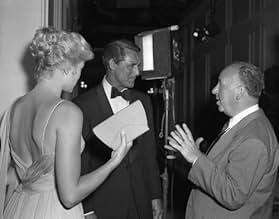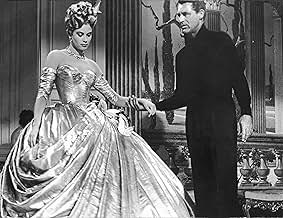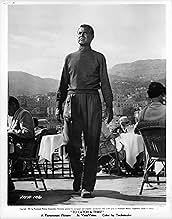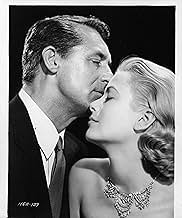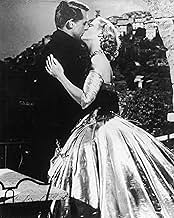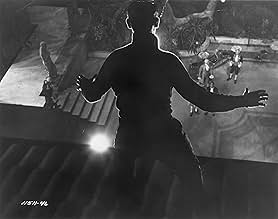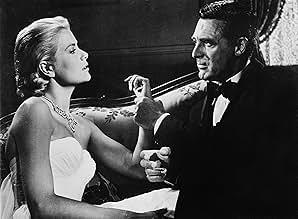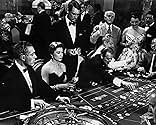Un ladrón de joyas jubilado se propone demostrar su inocencia tras convertirse en sospechoso de un robo.Un ladrón de joyas jubilado se propone demostrar su inocencia tras convertirse en sospechoso de un robo.Un ladrón de joyas jubilado se propone demostrar su inocencia tras convertirse en sospechoso de un robo.
- Dirección
- Guionistas
- Elenco
- Ganó 1 premio Óscar
- 1 premio ganado y 5 nominaciones en total
George Adrian
- Detective
- (sin créditos)
John Alderson
- Detective at the Costume Ball
- (sin créditos)
Martha Bamattre
- Kitchen Helper
- (sin créditos)
René Blancard
- Commissaire Lepic
- (sin créditos)
Eugene Borden
- French Waiter
- (sin créditos)
Nina Borget
- Frenchwoman
- (sin créditos)
George Boyce
- Party Guest
- (sin créditos)
John Breen
- Party Guest
- (sin créditos)
Margaret Brewster
- Cold-cream Woman
- (sin créditos)
Ralph Brooks
- Casino Patron
- (sin créditos)
- Dirección
- Guionistas
- Todo el elenco y el equipo
- Producción, taquilla y más en IMDbPro
Resumen
Reviewers say 'To Catch a Thief' is celebrated for its cinematography, vibrant colors, and picturesque French Riviera locations. Cary Grant and Grace Kelly's chemistry and performances are highly praised. However, some find the plot less engaging and the suspense lacking compared to other Hitchcock films. The lighter tone and romantic elements receive mixed opinions, while the beautiful costumes and set designs are standout features.
Opiniones destacadas
The best thing about this film is the chemistry between leads Grant and Kelly. Grant is as debonair as usual and Kelly was never more glamorous. The costumes she wears are very flattering to her and she is to the clothes. The dialogue between them sparkles throughout and is a pleasure to watch even if the course of their relationship is predictable. Grant's self-deprecating in-jokes are another nice touch. Further pleasantly adding to the fantasy ambience is the spectacular photography of the French riviera. John Williams is also great as the insurance investigator, the type of character he played in Hitchcock's Dial M for Murder (also with Kelly) and in the Doris Day-Rex Harrison film, Midnight Lace. This film is not one of the most psychologically involving in Hitchcock's pantheon but it is not designed to be. It is enjoyed best as what it was produced to be: glossy high production value escapist fare. 8/10.
Alfred Hitchcock is really having fun here, and so are Cary Grant and Grace Kelly. The Mediterranean coast is a stunning backdrop for their gorgeous outdoor scenes, and the great director leads us around the mystery at the heart of this story by alternating between tense chases, high-toned sexual innuendo, and moments of levity. Not to be missed.
There is much to like about Hitchcock's TO CATCH A THIEF: Cary Grant and Grace Kelly at the height of their appeal, a witty script that offers Jessie Royce Landis one of the funniest roles ever seen in any Hitchcock film, and excellent cinematography designed to show off the beauties of Monte Carlo--all packaged in a lightweight tale that is two parts romance, two parts travelogue, one part comedy, and just enough classic Hitchcock suspense to keep this lighter-than-air confection from flying apart.
The well known story concerns a string of jewel robberies along the Riviera which lead local officials to suspect that a famous and long retired cat burglar (Grant) is once more on the prowl--but rather than hope the authorities will find the real culprit Grant elects to protect himself by unmasking the thief for himself. In the process he encounters an icy beauty (Kelly) who takes considerable pleasure in tantalizing him with her charms, her jewels, and her knowledge of his criminal past, and her mother (Landis), who is perhaps the best of the "clever matrons" to appear in any Hitchcock film. As the police close in, the three of them devise a plot to expose the thief and clear Grant, with whom Kelly has now fallen in love.
Unlike most Hitchcock's most famous films, TO CATCH A THIEF offers nothing dark to trouble our thoughts, and it is perhaps best regarded as a romantic fantasia, the director's vacation from his more typical material. While it will never compete with the more famous VERTIGO and REAR WINDOW of the same period, it is extremely well done and quite a bit of fun to watch. Viewers seeking a pleasant film with a romantic touch will enjoy it a great deal.
Gary F. Taylor, aka GFT, Amazon Reviewer
The well known story concerns a string of jewel robberies along the Riviera which lead local officials to suspect that a famous and long retired cat burglar (Grant) is once more on the prowl--but rather than hope the authorities will find the real culprit Grant elects to protect himself by unmasking the thief for himself. In the process he encounters an icy beauty (Kelly) who takes considerable pleasure in tantalizing him with her charms, her jewels, and her knowledge of his criminal past, and her mother (Landis), who is perhaps the best of the "clever matrons" to appear in any Hitchcock film. As the police close in, the three of them devise a plot to expose the thief and clear Grant, with whom Kelly has now fallen in love.
Unlike most Hitchcock's most famous films, TO CATCH A THIEF offers nothing dark to trouble our thoughts, and it is perhaps best regarded as a romantic fantasia, the director's vacation from his more typical material. While it will never compete with the more famous VERTIGO and REAR WINDOW of the same period, it is extremely well done and quite a bit of fun to watch. Viewers seeking a pleasant film with a romantic touch will enjoy it a great deal.
Gary F. Taylor, aka GFT, Amazon Reviewer
This Hitchcock movie is not about suspense. It is about Grace Kelly, Cary Grant and the French Riviera. If you don't worry about the plot and just watch THEM, you will enjoy it immensely. Hitchcock went through what I call his "travelogue phase" which consisted of Dial M for Murder (London), Vertigo (San Francisco), North by Northwest (Mount Rushmore), and, here, The French Riviera. I consider this phase the time of his masterworks (before he became fixated on the macabre) and although this particular movie is the most insipid of the lot, it is his finest travelogue. For Americans of this period, the mention of Europe must have invoked black and white images of war. Not here!! One really wishes he could take a time machine back to this gloriously beautiful time and place. A movie that can enjoyably be watched time and again. However, I do agree with others that Grant was somewhat miscast as a thief -- even a high-class one.
When a number of jewel thefts take place on the French Riviera, suspicion falls on John Robie, an American expatriate. Robie was at one time a notorious jewel thief, but escaped from prison during the Second World War and joined the French Resistance. As a result of his bravery, he was paroled, and, although he now claims to be living an honest existence, the recent burglaries have all the hallmarks of his style. Robie has to clear his name of suspicion and expose the real "Cat", as the press have nicknamed the burglar. (The theme of a man unjustly accused or suspected of a crime was a common one with Hitchcock). Along the way, he finds time to flirt with Danielle, the attractive daughter of a local waiter, and to carry on a more serious romance with Frances Stephens, a glamorous American oil heiress.
Hitchcock is not, perhaps, a director whom one would normally associate with visual beauty, but as another reviewer has pointed out, this is perhaps his most visually beautiful film, with plenty of tourist-brochure shots of the Riviera. (The film won an Oscar for "Best Cinematography" and was nominated for two others, "Best Art Direction" and "Best Costume Design"). For the two main roles, he used two of his favourite actors, Cary Grant and Grace Kelly. In both cases, it was their third Hitchcock film; Grant would later go on to make a fourth, "North by Northwest". Kelly was one of the most beautiful Hollywood stars of all time, and Hitchcock catches her at her loveliest in this film, her beauty shown to its best advantage by some sumptuous costumes. Her verbal duels with Grant are one of the major features of the film; they sometimes turn into three-way contests when Danielle, played by Brigitte Auber, joins in. (Auber, incidentally, seems miscast. The exchanges between the two women suggest that Danielle is considerably younger than Frances, probably only a teenager. Auber, in fact, was a year older than Kelly).
This is possibly Hitchcock's most light-hearted film, apart from his few ventures into pure comedy such as "Mr and Mrs Smith". If one had to categorise it, it would probably be as a comedy-romance-thriller. Although Hitchcock made a few other films along similar lines, notably "North by Northwest", "To Catch a Thief" contains a greater element of comedy and a lesser element of thrills. There are no great set-piece suspense scenes comparable to the crop-duster and Mount Rushmore sequences in the later movie; indeed, there is very little suspense at all, except in the scene at the end where Robie confronts the "Cat" on the rooftops. The film to which it perhaps bears the greatest resemblance is "Charade", which also starred Cary Grant and an iconic beauty of the screen (in that case Audrey Hepburn) in a French setting. It was, of course, not directed by Hitchcock, but Stanley Donen had clearly absorbed elements of his style. Like "Charade", "To Catch a Thief" is highly enjoyable as a light, glossy romantic comedy, but lacks the tension and psychological depth of Hitchcock's best work. 7/10
Hitchcock is not, perhaps, a director whom one would normally associate with visual beauty, but as another reviewer has pointed out, this is perhaps his most visually beautiful film, with plenty of tourist-brochure shots of the Riviera. (The film won an Oscar for "Best Cinematography" and was nominated for two others, "Best Art Direction" and "Best Costume Design"). For the two main roles, he used two of his favourite actors, Cary Grant and Grace Kelly. In both cases, it was their third Hitchcock film; Grant would later go on to make a fourth, "North by Northwest". Kelly was one of the most beautiful Hollywood stars of all time, and Hitchcock catches her at her loveliest in this film, her beauty shown to its best advantage by some sumptuous costumes. Her verbal duels with Grant are one of the major features of the film; they sometimes turn into three-way contests when Danielle, played by Brigitte Auber, joins in. (Auber, incidentally, seems miscast. The exchanges between the two women suggest that Danielle is considerably younger than Frances, probably only a teenager. Auber, in fact, was a year older than Kelly).
This is possibly Hitchcock's most light-hearted film, apart from his few ventures into pure comedy such as "Mr and Mrs Smith". If one had to categorise it, it would probably be as a comedy-romance-thriller. Although Hitchcock made a few other films along similar lines, notably "North by Northwest", "To Catch a Thief" contains a greater element of comedy and a lesser element of thrills. There are no great set-piece suspense scenes comparable to the crop-duster and Mount Rushmore sequences in the later movie; indeed, there is very little suspense at all, except in the scene at the end where Robie confronts the "Cat" on the rooftops. The film to which it perhaps bears the greatest resemblance is "Charade", which also starred Cary Grant and an iconic beauty of the screen (in that case Audrey Hepburn) in a French setting. It was, of course, not directed by Hitchcock, but Stanley Donen had clearly absorbed elements of his style. Like "Charade", "To Catch a Thief" is highly enjoyable as a light, glossy romantic comedy, but lacks the tension and psychological depth of Hitchcock's best work. 7/10
¿Sabías que…?
- TriviaCary Grant had announced his retirement from acting in February 1953, stating that, since the rise of Method actors like Marlon Brando, most people were no longer interested in seeing him. He was also angry at the way Sir Charles Chaplin had been treated by the HUAC. He was lured out of his retirement to make this movie, and thereafter continued acting for a further eleven years.
- ErroresOn the list of jewelry owners, the room number of Mrs. Jessie Stevens is given as 541, but when John Robie accompanies Mrs. Stevens and her daughter to their rooms, the numbers on their doors are 625 and 623, respectively.
- Citas
Frances Stevens: Mother, the book you're reading is upside down!
- Créditos curiososThe opening title sequence shows the window of a travel agent, with the text of the titles superimposed. The bottom of the window is not quite horizontal because the window is seen from a slight angle to perpendicular. The text of the titles is given slight parallelogram distortion so the bottom line of text is parallel to the window-sill, and therefore it is not horizontal and parallel with the film frame.
- ConexionesEdited into Histoire(s) du cinéma: Seul le cinéma (1994)
Selecciones populares
Inicia sesión para calificar y agrega a la lista de videos para obtener recomendaciones personalizadas
- How long is To Catch a Thief?Con tecnología de Alexa
- what is the make of the car the made is driving at the beginning?
- Cary Grant---When Was He Signed?
- What does the newspaper clipping say?
Detalles
Taquilla
- Presupuesto
- USD 2,500,000 (estimado)
- Total a nivel mundial
- USD 7,117
- Tiempo de ejecución1 hora 46 minutos
- Color
- Relación de aspecto
- 1.85 : 1
Contribuir a esta página
Sugiere una edición o agrega el contenido que falta

Principales brechas de datos
By what name was Para atrapar al ladrón (1955) officially released in India in Hindi?
Responda






